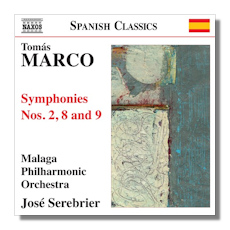
The Internet's Premier Classical Music Source
Related Links
- Marco Reviews
- Latest Reviews
- More Reviews
-
By Composer
-
Collections
DVD & Blu-ray
Books
Concert Reviews
Articles/Interviews
Software
Audio
Search Amazon
Recommended Links
Site News
 CD Review
CD Review
Tomás Marco

Symphonies
- Symphony #2 "Espacio cerrado"
- Symphony #9 "Thalassa"
- Symphony #8 "Gaia's Dance"
Malaga Philharmonic Orchestra/José Serebrier
Naxos 8.572684 62min
Madrid-born Tomás Marco (b. 1942) was a student of Boulez, Stockhausen, Ligeti and Maderna, but, if I can judge by the works offered here, his music has turned out to be less aggressively modern, or avant-garde, than theirs. That said, many listeners will still consider it challenging to the ear. The Second and Ninth Symphonies are indeed a tough pair to warm up to on first or second hearing, while the Eighth is more immediately appealing in its vibrant rhythms and colorful orchestration. The Eighth and Ninth, by the way, receive their recording premieres here.
The one-movement Second Symphony roils and froths and seethes with tension, coming across almost like a Spanish take on the style of Swedish symphonist Allan Pettersson. But Marco is a bit more colorful in orchestration, especially in his use of percussion, and his music does not sound angry or full of rage, as is often the case with Pettersson. The Second Symphony lasts only fifteen minutes and expresses a sort of suffocating dark world: the subtitle "Espacio cerrado" (Closed space) is, according to the composer, a kind of "spiral closing in on itself". He sees this 1985 work as a desolate piece of tragic character, although it is abstract in expression, not programmatic.
The Ninth Symphony (2009) comes next on this CD. It seems to pick up where the Second left off but, cast in two movements, it is both longer and more varied in mood. It is full of spasmodic outbursts and conveys a sense of chaos in the first movement, as the composer intended: the opening panel is subtitled "Nun", after the god of water in Egyptian mythology, who supposedly played a key role in the creation of the world, as life emerged from the waters. The second and final movement is subtitled "Okéanos", after the Greek mythological Titan Oceanus, thus extending the "water" concept from the first movement and uniting with it to spawn the symphony's nickname "Thalassa", after the primordial Greek goddess of the sea. The music takes on a more fluid sense, no pun intended, and the chaotic feel from the first movement has now yielded to a more stable, more formally grounded manner. Still, there are both a rawness and primordial character that remain to the end.
The Eighth Symphony (2008) begins with an attractive, exotic drum rhythm played by the djembe, an African percussion instrument. There are glissando shrieks and other instrumental effects that add to the colorful sound world of the opening movement, which is subtitled Godwana, the name of the landmass hundreds of millions of years ago that included Africa and South America. Appropriately, the music uses dance features of Latin America and African origin. The second movement, "Laurasia", ancient name for the landmass once comprised of Europe and Asia, begins slowly and gloomily but then also turns rhythmic and somewhat exotic. The finale, Pangea, the name for the super-landmass from the Paleozoic and Mesozoic eras that included virtually all land on Earth, begins with an array of percussion instruments which are then joined by an exotic bassoon dance theme. Various musical styles from across the globe are used in this, perhaps the most eclectic movement in any of the symphonies.
The performances by the Malaga Philharmonic, under the baton of veteran conductor José Serebrier, are convincing in every way. Naxos provides excellent sound, and the notes by the composer are invaluable. If you like contemporary orchestral music of progressive but not avant-garde character, you may well find this Tomás Marco disc to your liking.
Copyright © 2012 by Robert Cummings.





















